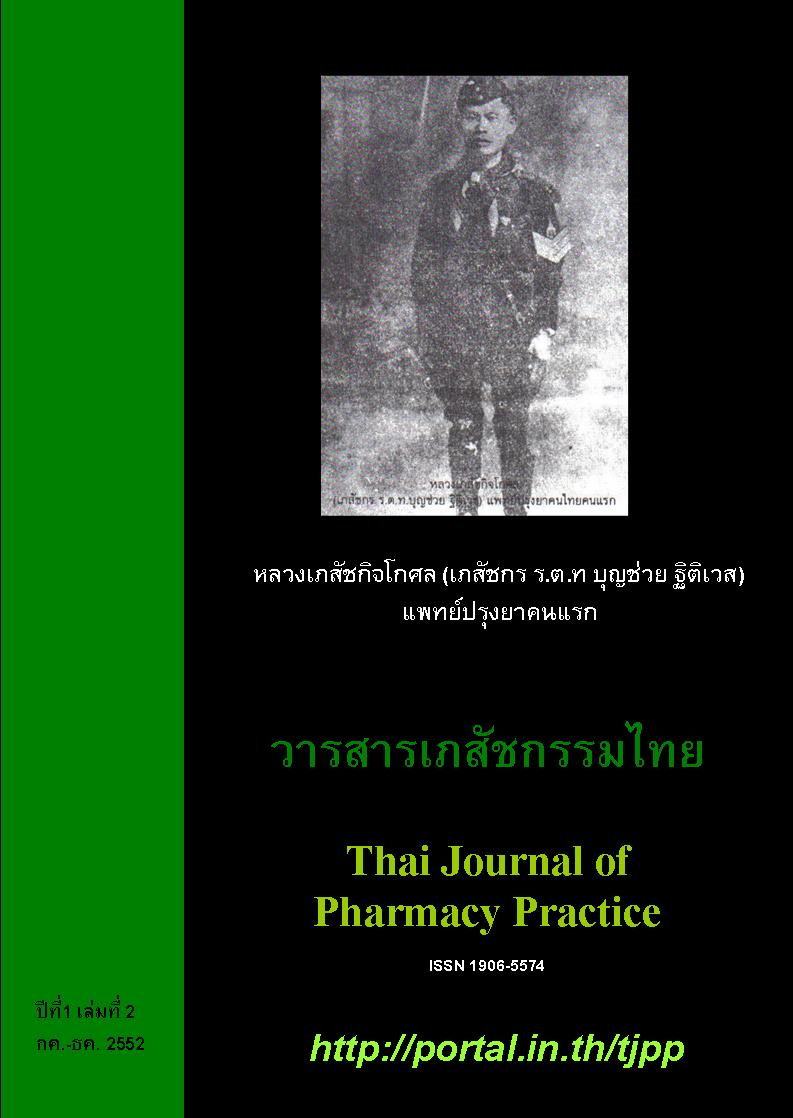Development of a Model for Drug Information Service System in Regional Hospitals: A Delphi Approach
Main Article Content
Abstract
Objective: To develop a feasible model for drug information service (DIS) system in regional hospitals to provide proactive services to meet the need of physicians. Methods: Two rounds of data collection using the Delphi technique were conducted. The questionnaires were e-mailed to 32 experts selected by snowball sampling technique consisting of 3 academicians, 12 pharmacists (service providers) and 17 physicians (service users). The researchers analyzed the data to find out indispensable characteristics of DIS from expert consensus summarized by median, difference between median and mode, and inter-quartile range. Results: Twenty nine experts (90.6%) completed the questionnaires at both surveys. This study identified three groups of essential characteristics of DIS system: structures, processes and outcomes. Structural characteristics included having 3 pharmacists with one providing full-time services, staff having at least 2 year experiences in clinical pharmacy or pharmacy practice and computer skills for searching drug information, having two technical assistants, having a service counter and physically located in the pharmacy department, being administered by a multidisciplinary committee, being mainly financed by the affiliated hospital, and possessing a number of drug information databases and reference books. Essential process characteristics included drug information answering service, pharmacovigilance, drug utilization evaluation, supporting of drug information for pharmacy and therapeutic committee, trainings and educations, provision of drug information via newsletter/bulletin, arranging the conferences for continuing education, provision of seethe service from 8.00-16.00 during the weekday, having channels to access the service after office hours, providing both walk-in and phone service, having a quality assurance for DIS by the internal reviewers and two-way verification with the service clients and having the systematic computerized information storage. Essential outcome characteristics were the continuous assessment of the DIS in important dimensions (accuracy, comprehensiveness, suitability, up-to-date information and benefit in resolving patient’s problem), monthly assessment of client’s satisfaction in clarity, relevancy, adequacy, timeliness and convenience to access the services, the assessment of service impact on patient outcomes from the opinion of in-charge physicians, patient progress from medical charts and patient interview, the documentation of number and types of services provided, clients, sources of information used and number of answers beneficial for resolving patient’s problems. Conclusion: The result of this study can be used as a blueprint for setting a client
Article Details
ผลการวิจัยและความคิดเห็นที่ปรากฏในบทความถือเป็นความคิดเห็นและอยู่ในความรับผิดชอบของผู้นิพนธ์ มิใช่ความเห็นหรือความรับผิดชอบของกองบรรณาธิการ หรือคณะเภสัชศาสตร์ มหาวิทยาลัยสงขลานครินทร์ ทั้งนี้ไม่รวมความผิดพลาดอันเกิดจากการพิมพ์ บทความที่ได้รับการเผยแพร่โดยวารสารเภสัชกรรมไทยถือเป็นสิทธิ์ของวารสารฯ
References
2. พิมลวรรณ ทัพยุทธวิจารณ์, เพียงจิต สัตตบุษย์, สุพรชัย กองพัฒนากูล. ศูนย์ข้อมูลยา. สารศิริราช 2538;47:255-60.
3. Cardoni AA, Thompson TJ. Impact of drug information services on patient care. Am J Hosp Pharm 1978;35:1233-7.
4. Hands D, Stephens M, Brown D. A systematic review of the clinical and economic impact of drug information services on patient outcome. Pharm World Sci 2002;24:132-8.
5. Melnyk P, Shevchuk Y, Remillard A. Impact of the dial access drug information service on patient outcome. Ann Pharmacother 2000;34:585-92.
6. Bond CA, Raehl CL, Franke T. Clinical pharmacy services and hospital mortality rates. Pharmacotherapy 1999;19:556-64.
7. ธีราพร ชนะกิจ, นิตยา ดาววงศ์ญาติ, ชาลี ภูมิฐาน, สำราญ นนทรักษ์, วิรัตน์ พวงจันทร์. การประกันคุณภาพงานบริการเภสัชสนเทศ ณ โรงพยาบาลสรรพสิทธิประสงค์. ไทยเภสัชศาสตร์และวิทยาการสุขภาพ 2550;2:138-50.
8. พนารัตน์ แสงแจ่ม, พัชรี ลักษณะวงศ์ศรี, กนกวรรณ ชัยพร, มยุรี ตั้งเกียรติกำจาย, เจริญ ตรีศักดิ์. บริการเภสัชสนเทศทางโทรศัพท์: ประสบการณ์โรงพยาบาลเอกชน. ศรีนครินทรวิโรฒเภสัชสาร2548;10:48-57.
9. วรนัดดา ศรีสุพรรณ. การประเมินคุณภาพการตอบคำถามของหน่วยเภสัชสนเทศในโรงพยาบาลศูนย์/โรงพยาบาลทั่วไป [วิทยานิพนธ์เภสัชศาตรมหาบัณฑิต]. ขอนแก่น: มหาวิทยาลัยขอนแก่น; 2543.
10. Rosenberg J, Koumis T, Nathan J, Cicero L, McGuire H. Current status of pharmacist-operated drug information centers in the United States. Am J Health Syst Pharm 2004;61:2023-32.
11. สมาคมเภสัชกรรมโรงพยาบาล The Association of Hospital Pharmacy (Thailand). มาตรฐานวิชาชีพเภสัชกรรมโรงพยาบาล [ออนไลน์]. 2551 [สืบค้นวันที่ 15 มกราคม 2551]. เข้าถึงได้จาก: URL:http://www.thaihp.org/index.php?lang=th&option=contentpage&sub=29.
12. Macmillan T. The Delphi Technique. Annual Meeting of the California Junior Colleges Associations Committee on Research and Development; Monterey; 1971 May 3-5; California, US.
13. ผกาวดี สุพรรณจิตวนา. การพัฒนารูปแบบการมีส่วนร่วมของประชาชนในการบริหารการพัฒนางานสาธารณสุขมูลฐานโดยใช้เทคนิคเดลฟาย [วิทยานิพนธ์ศิลปศาสตรมหาบัณฑิต]. ขอนแก่น: มหาวิทยาลัยขอนแก่น; 2545.
14. พบส. (โครงการพัฒนาระบบบริการของสถานบริการและหน่วยงานสาธารณสุขในส่วนภูมิภาค). เกณฑ์มาตรฐานพัฒนาระบบบริการของสถานบริการและหน่วยงานสาธารณสุข: งานเภสัชกรรม. กรุงเทพมหานคร: กระทรวงสาธารณสุข; 2539.
15. Najabat M, Bowey J, Hands D, Brown D. Drug information and patient care. Pharm World Sci 1999;21 Suppl: A8.
16. Stubbington C, Bowey J, Hands D, Brown D. Drug information replies to queries involving adverse events: impact on clinical practice. Hosp Pharm 1998;5:81-4.
17. Tugwell C, editor. Assessing the impact of drug information to professionals on patients in community and hospital. European Society of Clinical Pharmacy Special Interest Group for Drug Information - mini symposium during ACCP-ESCP Conference; 1999 April 11; Orlando, US.
18. Kinky D, Erush S, Laskin M, Gibson G. Economic impact of a drug information service. Ann Pharmacother 1999;33:11-6.

